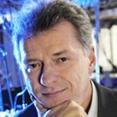Quantum Measurement of Motion in the Negative Mass Reference Frame
Hosted By: Quantum Computing and Communication Technical Group
10 April 2019 11:00 - 12:00
Eastern Time (US & Canada) (UTC -05:00)Quantum mechanics dictates that a continuous measurement of the position of an object imposes a random quantum back action (QBA) perturbation on its momentum. This randomness translates with time into position uncertainty, thus leading to the well-known uncertainty on the measurement of motion. As a consequence, and in accordance with the Heisenberg uncertainty principle, the QBA puts a limitation—the so-called standard quantum limit—on the precision of sensing of position, force and fields.
In this webinar hosted by the OSA Quantum Computing and Communication Technical Group, Dr. Eugene Polzik of Neils Bohr Institute will present the ideas and experimental results for measurement of motion of a mechanical oscillator with the precision not restricted by the QBA. This is achieved by measuring the motion in a special reference frame linked to an atomic spin system with an effective negative mass. Applications to force sensing and gravitational wave detection will also be discussed. Participants will learn about overcoming standard quantum limits for measurements of magnetic field and position of a nano-object. This webinar will be beneficial to anyone whose research is related to quantum optics, quantum information, and quantum metrology.
What You Will Learn:
- Overcoming standard quantum limits for measurements of magnetic field and position of a nano-object
Who Should Attend:
- Individuals whose research is related to quantum optics, quantum information, and quantum metrology
About the Presenter: Eugene Polzik, Niels Bohr Institute

Eugene Polzik received a master’s degree in Physics from St. Petersburg University in 1976 and his PhD in 1980. He continued as an associate professor until 1988, and then moved to the US. He went to the California Institute of Technology and became part of the research group that was one of the first in the world to carry out teleportation from light to light. He moved to Denmark and became Professor of Atomic, Molecular and Optical Physics at Aarhus University in 1999, and in 2001 he won a grant from Danish National Research Foundation for QUANTOP at Aarhus University, the first major Nordic research center in modern quantum physics. In 2003, he moved the center to the Niels Bohr Institute at the University of Copenhagen. In 2006, he became a member of the Royal Danish Academy of Sciences and Letters. In 2010 he was given the Gordon Moore Distinguished Scholar Award in recognition of his work within quantum information, quantum optics and quantum metrology.
